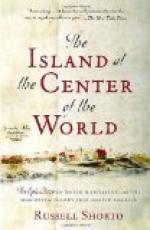At the outbreak of the war the people’s grievance had been simply taxation without representation, but by this time the desire for complete independence had taken fast hold of them. This feeling swept through the colonies, and when the Continental Congress met in June of this year, it voted that the united colonies should be free and independent States and have no further political connection with Great Britain. A declaration of independence was adopted on July 4th, and the British colonies became the United States of America.
A horseman brought the news to New York, and there was great rejoicing. The soldiers of the new Union then in the city were ordered to the Common, and there, early in the evening, standing in a hollow square—close by where the City Hall is now—and surrounded by a great concourse of people, Washington read the address that proclaimed the birth of a free and independent nation.
Following the reading the great throng applauded and then, filled with enthusiasm, rushed away. At the City Hall in Wall Street they tore down the painting of King George III. and trampled it under foot. On again they went to the Bowling Green, and there they dragged down the statue of the same royal person which had been erected only a few years before. The scattered fragments of the leaden statue were afterward gathered up and moulded into bullets.
This same month General William Howe, commander of the British army, had landed on Staten Island, with his brother, Admiral Howe of the British navy, and with the soldiers and sailors of their commands, made up a fine, well-drilled army of 35,000 men, who had come to fight a force of 20,000 recruits; men not at all well-versed in war, and nearly half of whom were ill and not able to be on duty.
But Washington calmly watched the British on Staten Island, and the British ships, more than 400 of them, in the bay, and was not at all dismayed. Once General Howe wrote to Washington suggesting measures that would lead to peace, but nothing came of it.
Late in the month of August the fighting commenced. General Howe led his forces to Long Island—led 21,000 men, for he thought that the best way to capture New York was to first vanquish the army on Long Island by an overwhelming force. Then the subduing of the city across the river would be easy.
Washington hurried what men he could across to Long Island to assist those already there. But even then the Americans were outnumbered as two to one. The patriots fought long and well, but they were defeated. Two hundred or more were killed, and three times as many, including three generals, were made prisoners. But more than 300 of the British were also killed.




